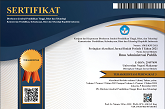Facing the Threat of Modern Islamic State Insurgence to Increase National Resilience
(1) Doctoral Study Program, Universitas Pertahanan RI, Bogor
(2) Doctoral Study Program, Universitas Pertahanan RI, Bogor
(3) Doctoral Study Program, Universitas Pertahanan RI, Bogor
(*) Corresponding Author
DOI: https://doi.org/10.26858/jiap.v11i1.23116
Abstract
The threat of insurgency or modern rebellion of Islamic State in Indonesia is strongly influenced by the Southeast Asian regional environment which has a region with religious, ethnic, and cultural diversity. Ethnic, religious, racial, and intergroup conflicts have caused economic, political, and psychological losses. This article aims to describe and analyze using a variety of approaches applied in Indonesia to face the modern insurgency of the Islamic State using qualitative analysis methods. The technique of collecting data and information is through literature study. There are several jihadi organizations and groups that carry out operations, such as Jamaah Islamiyah, the Indonesian Mujahideen Council, and others. The vitality of radical and extremist groups is able to rise to renew leadership in the organizational network structure based on personal closeness, friendship, and family. National resilience as a dynamic condition of the nation and the conception of national development in achieving the goals and ideals of the nation, which is tough and tenacious and capable of developing national strength in dealing with all kinds and forms of threats, challenges, obstacles, and disturbances both coming from within and from within. outside, which threatens and endangers the integrity, identity and survival of the nation and state, especially the threat of modern Islamic State insurgency. Modern insurgency may never develop sufficient military strength to carry out conventional operations and must therefore rely on terrorism and psychological and political means. Therefore, facing the threat of the Islamic State, the Government of Indonesia must map the transformation of ISIS in Southeast Asia, especially in Indonesia, so that it is faced with proportional efforts and actions such as dealing with domestic insurgency, regional cooperation, and the involvement of extraregional forces within the ASEAN framework.
Full Text:
PDFReferences
Addiansyah, M. N. (2019). Koalisi Partai Politik Islam Pada PILPRES 2019: Antara Ideologis dan Pragmatis. Jurnal Pemikiran Politik Islam POLITEA, 2(2), 189–198.
Amin, K. (2018). ISIS Menuju Asia Tenggara: Ancaman dan Kerja Sama Keamanan Kawasan dalam Menghadapi Peningkatan Ekspansi ISIS. Jurnal Hubungan Internasional, 6(2), 1–13.
Aswar, H. (2018). Destructing the Islamist in Indonesia: Joko Widodo Policy and Its Controversy. International Journal of Malay-Nusantara Studies, 1(1), 62–79.
Chaidar, A. (2020). Masyarakat Mindanao, Abu Sayyaf dan Masalah Keamanan Kawasan. Jurnal Cakrawala, 1–44.
Djelantik, S., & Akbar, T. . (2016). Terorisme Internasional dan Fenomena ISIS di Indonesia. Bandung: LP2M Universitas Katolik Parahyangan.
Fadhly, F. (2018). Pemahaman Keagamaan Islam di Asia Tengggara Abad XIII-XX. Jurnal Studi Agama Milla, 18(1), 51–78.
Haryadi, A., & Muthia, N. (2017). Gerakan Politik Negara Islam Irak dan Suriah (ISIS) dan Pengaruhnya terhadap Indonesia. urnal Transborders, 1(1), 1–17.
Helmiati. (2014). Sejarah Islam Asia Tenggara. Pekanbaru: LP2M Universitas Islam Negeri Sultan Syarif Kasim.
Ismail, F. (1999). Ideologi Hegemoni dan Otoritas Agama. Yogyakarta: Tiara Wacana.
Kettani, H. (2009). Muslim Population in Asia. International Journal of Environmental Science and Development, 1–9.
Liow, J. . (2006). Muslim Resistence in Southern Thailand and Southern Philippines: Religion, Ideology and Politics. Washington DC: East-West Center.
Lisbet. (2017). ASEAN dan Isu Laut China Selatan. Jakarta: Majalah Info Singkat Hubungan Internasional DPRRI.
Nainggolan, P. P. (2018). Kerja Sama Internasional Melawan Terorisme. Jakarta: Yayasan Pustaka Obor Indonesia.
Suproboningrum, L., & Kurniawan, Y. (2017). Diplomasi Maritim dalam Keberhasilan Patroli Terkoordinasi Indonesia-Malaysia-Singapura di Selat Malaka. Jurnal Politica, 8(2), 163–187.
Syarif, H. (2019). Ini 5 Kelompok Teroris yang Masih Aktif di Indonesia. Diambil dari https://nasional.sindonews.com/read/380478/15/ini-5-kelompok-teroris-yang-masih-aktif-di-indonesia-1617033804
Tamtomo, A. B. (2019). NFOGRAFIK: Perolehan Suara Partai Politik dalam Pemilu 2019 Versi KPU. Diambil dari https://nasional.kompas.com/read/2019/05/22/16141831/infografik-perolehan-suara-partai-politik-dalam-pemilu-2019-versi-kpu
The Straits Times. (2018). Malaysia General Elections: Result. Retrieved from The Straits. Diambil dari https://graphics.straitstimes.com/STI/STIMEDIA/Interactives/2018/05/malaysia-general-elections-live-results/index.html
TNI Angkatan Laut. (2021). Data-data Operasi. Jakarta: Pusat Komando dan Pengendalian.
Wingarta, P. S. (2016). Rejuvenasi Bhinneka Tunggal Ika (Pendekatan Kewaspadaan Nasional). Jurnal Kajian Lemhannas RI, 26, 17–31.
Yunanto, S. (2017). Ancaman dan Strategi Penanggulangan Terorisme di Dunia dan Indonesia. Bekasi: Institute for Peace and Security Studies.
Article Metrics
Abstract view : 209 times | PDF view : 33 timesRefbacks
- There are currently no refbacks.
Copyright (c) 2021 Suharto Ladjide, Pujo Widodo, Resmanto Widodo Putro

This work is licensed under a Creative Commons Attribution 4.0 International License.
Diterbitkan oleh:
Program Studi Ilmu Administrasi Publik
Program Pascasarjana Universitas Negeri Makassar
JIAP Index By:

This work is licensed under a Creative Commons Attribution 4.0 International License.









